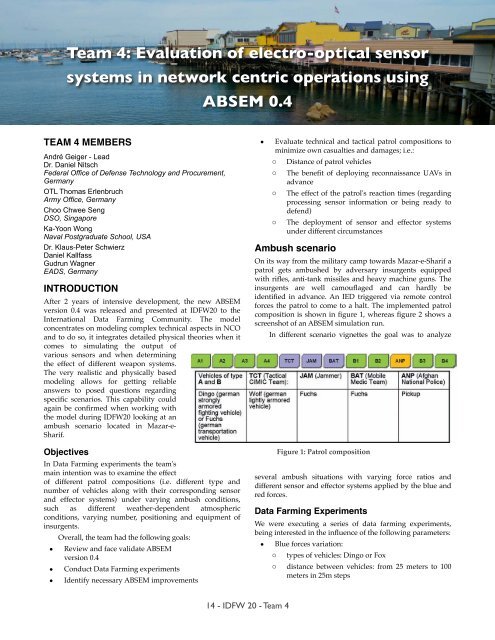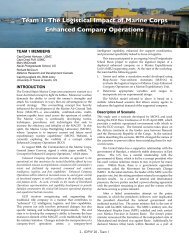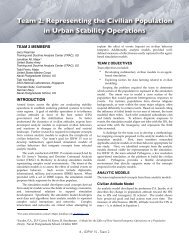pdf file - SEED Center for Data Farming - Naval Postgraduate School
pdf file - SEED Center for Data Farming - Naval Postgraduate School
pdf file - SEED Center for Data Farming - Naval Postgraduate School
You also want an ePaper? Increase the reach of your titles
YUMPU automatically turns print PDFs into web optimized ePapers that Google loves.
Team 4: Evaluation of electro-optical sensor<br />
systems in network centric operations using<br />
ABSEM 0.4<br />
TEAM 4 MEMBERS<br />
André Geiger - Lead<br />
Dr. Daniel Nitsch<br />
Federal Office of Defense Technology and Procurement,<br />
Germany<br />
OTL Thomas Erlenbruch<br />
Army Office, Germany<br />
Choo Chwee Seng<br />
DSO, Singapore<br />
Ka-Yoon Wong<br />
<strong>Naval</strong> <strong>Postgraduate</strong> <strong>School</strong>, USA<br />
Dr. Klaus-Peter Schwierz<br />
Daniel Kallfass<br />
Gudrun Wagner<br />
EADS, Germany<br />
INTRODUCTION<br />
After 2 years of intensive development, the new ABSEM<br />
version 0.4 was released and presented at IDFW20 to the<br />
International <strong>Data</strong> <strong>Farming</strong> Community. The model<br />
concentrates on modeling complex technical aspects in NCO<br />
and to do so, it integrates detailed physical theories when it<br />
comes to simulating the output of<br />
various sensors and when determining<br />
the effect of different weapon systems.<br />
The very realistic and physically based<br />
modeling allows <strong>for</strong> getting reliable<br />
answers to posed questions regarding<br />
specific scenarios. This capability could<br />
again be confirmed when working with<br />
the model during IDFW20 looking at an<br />
ambush scenario located in Mazar-e-<br />
Sharif.<br />
Objectives<br />
In <strong>Data</strong> <strong>Farming</strong> experiments the team's<br />
main intention was to examine the effect<br />
of different patrol compositions (i.e. different type and<br />
number of vehicles along with their corresponding sensor<br />
and effector systems) under varying ambush conditions,<br />
such as different weather-dependent atmospheric<br />
conditions, varying number, positioning and equipment of<br />
insurgents.<br />
Overall, the team had the following goals:<br />
• Review and face validate ABSEM<br />
version 0.4<br />
• Conduct <strong>Data</strong> <strong>Farming</strong> experiments<br />
• Identify necessary ABSEM improvements<br />
• Evaluate technical and tactical patrol compositions to<br />
minimize own casualties and damages; i.e.:<br />
o Distance of patrol vehicles<br />
o The benefit of deploying reconnaissance UAVs in<br />
advance<br />
o The effect of the patrol's reaction times (regarding<br />
processing sensor in<strong>for</strong>mation or being ready to<br />
defend)<br />
o The deployment of sensor and effector systems<br />
under different circumstances<br />
Ambush scenario<br />
On its way from the military camp towards Mazar-e-Sharif a<br />
patrol gets ambushed by adversary insurgents equipped<br />
with rifles, anti-tank missiles and heavy machine guns. The<br />
insurgents are well camouflaged and can hardly be<br />
identified in advance. An IED triggered via remote control<br />
<strong>for</strong>ces the patrol to come to a halt. The implemented patrol<br />
composition is shown in figure 1, whereas figure 2 shows a<br />
screenshot of an ABSEM simulation run.<br />
In different scenario vignettes the goal was to analyze<br />
Figure 1: Patrol composition<br />
several ambush situations with varying <strong>for</strong>ce ratios and<br />
different sensor and effector systems applied by the blue and<br />
red <strong>for</strong>ces.<br />
<strong>Data</strong> <strong>Farming</strong> Experiments<br />
We were executing a series of data farming experiments,<br />
being interested in the influence of the following parameters:<br />
• Blue <strong>for</strong>ces variation:<br />
o types of vehicles: Dingo or Fox<br />
o distance between vehicles: from 25 meters to 100<br />
meters in 25m steps<br />
14 - IDFW 20 - Team 4




